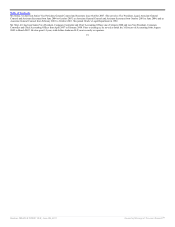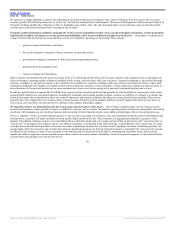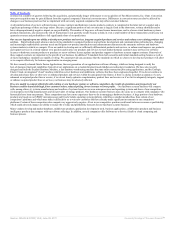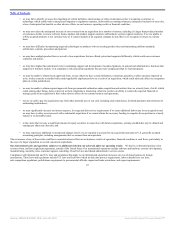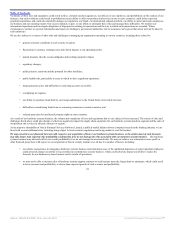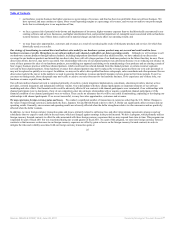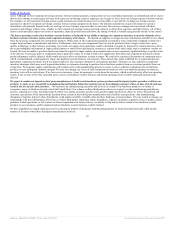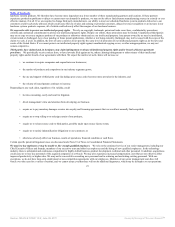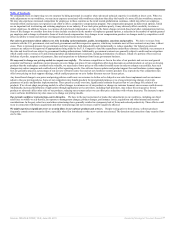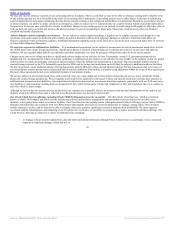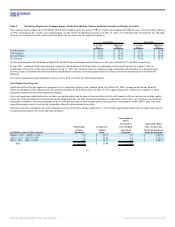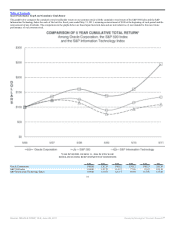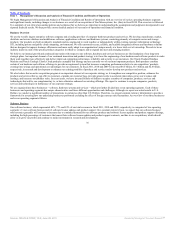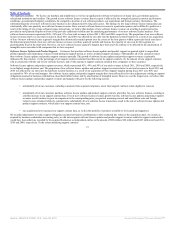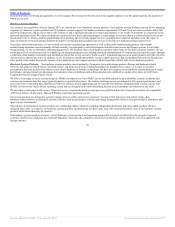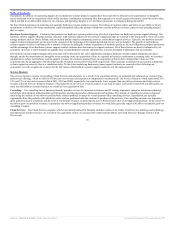Oracle 2010 Annual Report Download - page 33
Download and view the complete annual report
Please find page 33 of the 2010 Oracle annual report below. You can navigate through the pages in the report by either clicking on the pages listed below, or by using the keyword search tool below to find specific information within the annual report.
Table of Contents
consuming and costly. Errors in our software products could affect the ability of our products to work with other hardware or software products, could delay the
development or release of new products or new versions of products and could adversely affect market acceptance of our products. If we experience errors or
delays in releasing new software products or new versions of software products, we could lose revenues. In addition, we run our own business operations, Oracle
Cloud Services and other outsourcing services, support and consulting services, on our products and networks and any security flaws, if exploited, could affect
our ability to conduct our business operations. End users, who rely on our software products and services for applications that are critical to their businesses, may
have a greater sensitivity to product errors and security vulnerabilities than customers for software products generally. Software product errors and security flaws
in our products or services could expose us to product liability, performance and/or warranty claims as well as harm our reputation, which could impact our
future sales of products and services. In addition, we may be legally required to publicly report security breaches of our services, which could adversely impact
future business prospects for those services.
We may not receive significant revenues from our current research and development efforts for several years, if at all. Developing software and hardware
products is expensive, and the investment in product development often involves a long return on investment cycle. We have made and expect to continue to
make significant investments in research and development and related product opportunities. Accelerated product introductions and short product life cycles
require high levels of expenditures for research and development that could adversely affect our operating results if not offset by revenue increases. We believe
that we must continue to dedicate a significant amount of resources to our research and development efforts to maintain our competitive position. However, we
do not expect to receive significant revenues from these investments for several years, if at all.
We may face numerous risks in connection with our strategic alliance with Fujitsu. Oracle has had a relationship with Fujitsu for many years. We have
recently renegotiated a number of agreements with Fujitsu Limited with respect to collaborative sales and marketing efforts and the joint development and
manufacturing of some of our server products. The agreements contemplate that Oracle and Fujitsu dedicate substantial financial and human resources and, as a
result, the future performance of our hardware systems business may be impacted by the success or failure of this relationship.
If we fail to satisfy certain development or supply obligations under the agreements, or if we otherwise violate the terms of the agreements, we may be subject to
contractual or legal penalties. Further, if Fujitsu encounters potential problems in its business, such as intellectual property infringement claims, supply and
manufacturing difficulties, including difficulties that may result from the recent earthquake and tsunami in Japan, difficulties in meeting development milestones
or financial challenges, these problems could impact our strategic relationship with Fujitsu and could result in a material adverse effect on our hardware systems
business. There can be no assurance that our strategic relationship with Fujitsu will be successful, or that the economic terms of the agreements establishing the
relationship will ultimately prove to be favorable to us. The occurrence of any of these risks could have a material adverse effect on our hardware systems
business.
Business disruptions could affect our operating results. A significant portion of our research and development activities and certain other critical business
operations are concentrated in a few geographic areas. We are a highly automated business and a disruption or failure of our systems could cause delays in
completing sales and providing services, including some of our Cloud Services offerings. A major earthquake, fire or other catastrophic event that results in the
destruction or disruption of any of our critical business or information technology systems could severely affect our ability to conduct normal business operations
and, as a result, our future operating results could be materially and adversely affected.
There are risks associated with our outstanding and future indebtedness. As of May 31, 2011, we had an aggregate of $15.9 billion of outstanding
indebtedness that will mature between the remainder of calendar 2011 and calendar 2040, and we may incur additional indebtedness in the future. Our ability to
pay interest and repay the principal for our indebtedness is dependent upon our ability to manage our business operations, generate sufficient cash flows to
service such debt and the other factors discussed in this section. There can be no assurance that we will be able to manage any of these risks successfully.
29
Source: ORACLE CORP, 10-K, June 28, 2011 Powered by Morningstar® Document Research℠


